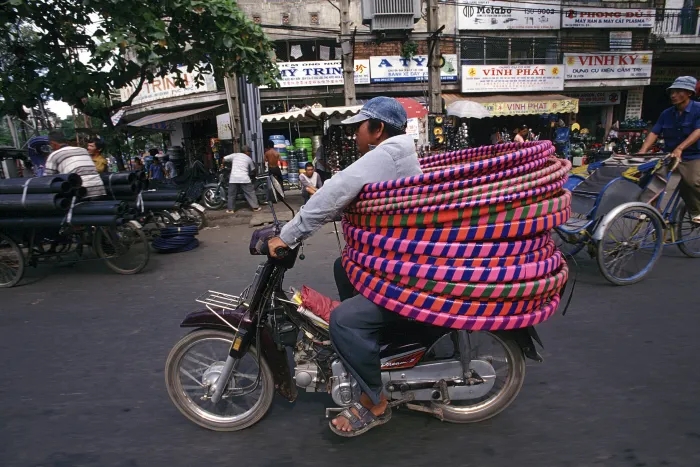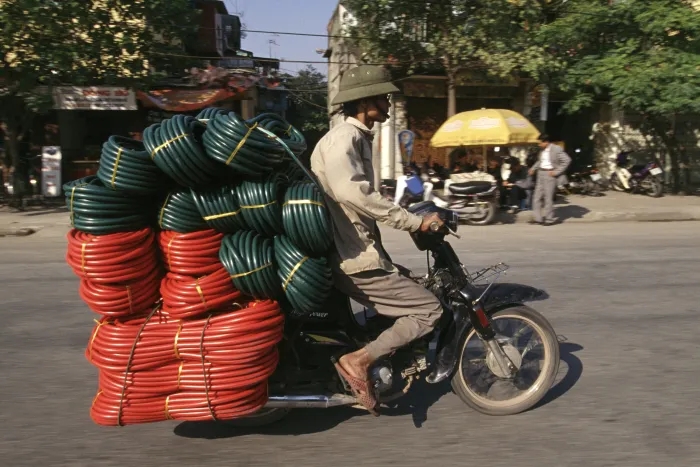
Working as a freelancer photographer in Hong Kong. He recalls that it was right before Tet (the Vietnamese Lunar New Year). “I arrived in Ho Chi Minh City, formerly Saigon, and felt a rush of excitement as I drove downtown in an old, beat-up Renault Dauphine. The streets were crowded with people doing their festival shopping. I checked in at a hotel located on Nguyen Hue Street. It was centrally located. I then went out to the street.
“I could not believe my eyes.” I was in the middle of a constant stream of motorbikes. I’m talking thousands. The people were dressed up. There was a family on a bicycle, men in suits and girls all dolled up. I was mesmerized and intoxicated by the scent of petrol, perfume, sound, colour, and motion. It was all so vibrant. “I felt I had come to the right place.”
He moved to Vietnam four years later. In 2000, a client approached him with a question that would stay with him for decades. Could he photograph motorbikes as they raced through the city carrying unimaginable loads of produce or other wares. After that chance assignment, he became obsessed with motorbikes. They played a major role in his city’s everyday life. He continued to document the motorbikes on his own time.
Kemp explains that “the Vietnamese economy in the 1990s and 21st Century consisted primarily (and to a great extent still does) of countless small business.” Little mom and pop stores, grocery shops, market stalls and so on. The Vietnamese insist on using fresh ingredients in every meal. They also have a high urban population density, narrow roads, low disposable income and motorbikes that are relatively affordable. Motorbikes are the only way to get around cities efficiently and quickly, and deliver goods and products multiple times per day.
“Cars are expensive and even though they could carry more, they’d get stuck in traffic. No parking spaces would be available, and people could not store large quantities of produce.
Kemp rode mainly with Mr. Minh. He was an experienced motorbike driver who could keep them safe and also chase down the most interesting motorcycles as they passed. In Vietnamese, motorbike taxis are known as Xe Om. He tells me that this literally means “vehicle hugging”. I was riding on the back of my friend and we would go out to explore. We were just cruising around and spotting. We would then do a U-turn and catch up to the bike. I would then try to take a photo of it as we drove parallel.
“Standing at a corner was not an alternative. You might get lucky and take a few shots. We continued to zigzag through the city, chasing any amazing loads we could. This continued for weeks, days, and even months. I rode my bike for hundreds of miles. “I got to really know the city grid-and also got to learn the meaning of the phrase ‘pain on the butt’.”
Kemp’s The Bikes of Burden reached a global audience by 2005. It represented for many a collective will to live better lives, a determination and will that was unique to Vietnam. The photographer recalls that Senator Max Baucus used the book in a speech about US-Vietnam Trade Relations to show why Vietnam deserved Permanent Normal Trade Relations. It was an important moment in the series’ history: The Bikes of Burden, as a policymaker. Vietnam received the special status two years later.”
Kemp, who has been traveling to Ho Chi Minh City for three decades, opened a new chapter of The Bikes of Burden by releasing A collection of 130 photos in non-fungible tokens. The photographer, who had spent his entire life on the road and was unable to travel, became unable during the pandemic. In the spring of 2021 a friend told him about crypto art.
He admits, “I didn’t know what NFTs stood for-not even the acronym.” After my initial reading, I jumped right in because I saw the potential of artists like me to find a source of income that was different from the old model. The old model of book sales and agent sales were definitely on their way out. I was able to see the new paradigm of the artist/photographer and collector/customer for the first time. I knew that I would have to give it my undivided focus to succeed. The Bikes of Burden seemed to be the natural choice for our first collection.
Kemp believes that the photos capture a place and time which, in many ways, is no longer there. He says that Vietnam has experienced rapid economic change in a very short time. “The streets in the big cities have been widened. The living conditions are better, people have more money and have less time to shop for fresh food.
“The public transport infrastructure is still very poor. There are few options to travel around. It is true that the bike is the best option to visit friends, have a good time, etc. The bike is still the best way to get around, whether you’re going out with friends, or on a night out. This entire series will be a testament to the Vietnamese’s ingenuity, and their willpower.”
